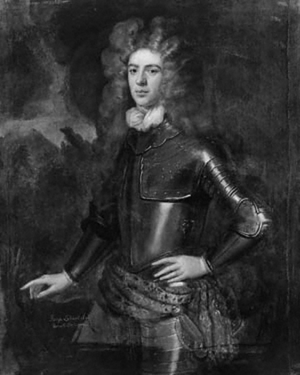George Lockhart (politician) facts for kids
Quick facts for kids
Sir George Lockhart
|
|
|---|---|

Portrait by Sir John Baptiste de Medina
|
|
| Member of Parliament for Midlothian | |
| In office 1708–1715 |
|
| Preceded by | New constituency |
| Succeeded by | John Baird |
| Member of Parliament for Wigtown Burghs | |
| In office 1708–1708 |
|
| Preceded by | New constituency |
| Succeeded by | William Cochrane |
| Commissioner for Edinburghshire | |
| In office 12 November 1702 – 25 March 1707 |
|
| Succeeded by | Constituency abolished |
| Personal details | |
| Born | 1673 |
| Died | 17 December 1731 (aged 58) |
| Political party | Tory |
| Other political affiliations |
Squadrone Volante |
| Profession | Politician |
Sir George Lockhart of Lee (1673 – 17 December 1731) was an important Scottish politician and writer. He was also known as Lockhart of Carnwath. He served in the Parliament of Scotland and later in the British House of Commons. He was a strong supporter of the Jacobite cause, which aimed to bring the Stuart family back to the throne.
Contents
Early Life and Education
George Lockhart was born in 1673. When he was only eight years old, his father passed away. George then inherited a large estate. His guardians, who had different political views, changed his teachers. They hired Presbyterian tutors, who also taught John Campbell, 2nd Duke of Argyll. George and John became good friends, even though they later had different political ideas.
As he grew up, George took charge of his own money and lands. He worked hard to improve his estate and use its coal mines. This made him one of the wealthiest people in Scotland who wasn't a noble. He also gained a lot of influence in areas like Lanarkshire. In 1697, he married Lady Euphemia Montgomerie.
Role in Scottish Parliament and the Union
In 1702, Lockhart became a representative for Edinburgh in the Parliament of Scotland. He joined a group of politicians who supported the King. He hoped to gain more freedom for Episcopalians, a religious group he favored. However, when this didn't happen, he became an opponent of the government.
He was very close to the Duke of Hamilton. However, he was often frustrated that the Duke didn't push harder for Jacobite goals. In 1705, George was chosen to be a commissioner for the union with England. He didn't want the job at first. But his Jacobite friends convinced him it would be useful. He could report back to them on what was happening.
George Lockhart strongly opposed the Union. He avoided signing the treaty. In Parliament, he was one of the loudest voices against it. He usually voted with those who were against the Union.
Life in the British Parliament
After Scotland and England united in 1707, Lockhart decided to become a Member of Parliament in the new British Parliament. He wanted to continue working for the Jacobite cause. He was elected to represent Edinburgh and also Wigtown burghs.
He was involved in the Jacobite rising of 1715, a rebellion that tried to restore the Stuart family to the throne. He helped with the preparations for this rebellion. After the rebellion failed, he was held in Edinburgh Castle. Luckily, his friend John Campbell helped him get released without a trial.
Lockhart continued to support James III, who was known as the "Old Pretender." In 1727, some of his letters were found by the government. He was warned that he was about to be arrested and managed to escape to Europe. Again, his friend John Campbell helped him. In 1728, he was allowed to return to Scotland. He lived quietly until his death in 1731.
His Writings
George Lockhart was also a writer. His writings, known as the "Lockhart Papers," are very important for understanding the history of the Jacobites. He wrote Memoirs of the Affairs of Scotland, which covered the time of Queen Anne up to the Union. This book was first published in 1714.
His writings also included his letters to the Pretender and other important papers. These were published together in 1817. Lockhart's writings helped reveal that some Scottish politicians were paid money before the Treaty of Union was signed. This led to the famous line by Robert Burns: "bought and sold for English gold."
Family Life
George Lockhart came from the Lockharts of Lee family. This family was very active in Scottish law and politics in the 1600s. He and his wife, Eupheme Montgomerie, had a large family.
His daughter, Grace Lockhart, married John Gordon, 3rd Earl of Aboyne.
See also

